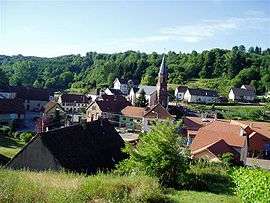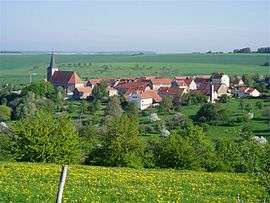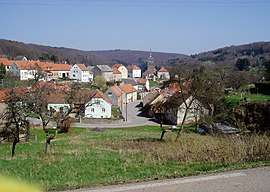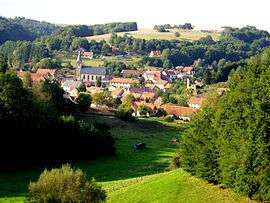Pays de Bitche
The Pays de Bitche (German: Bitscherland or Bitcherland) is a natural region located in the Moselle department of the Grand Est region of France. It corresponds to the present French part of the former principality of Zweibrücken-Bitsch and to the part of the Northern Vosges that lies within Lorraine.
Pays de Bitche Bitscherland / Bitcherland | |
|---|---|
Natural region | |
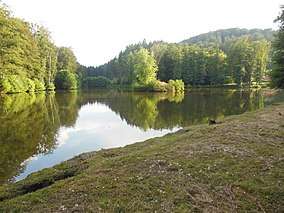 | |
 Pays de Bitche | |
| Coordinates: 49.0525°N 7.42583333333°E | |
| Country | France |
| Region | Grand Est |
| Department | Moselle |
| Arrondissement | Sarreguemines |
| Capital | Bitche |
| Area | |
| • Total | 61,589 km2 (23,780 sq mi) |
| Population (1999) | |
| • Total | 35,873 |
| • Density | 0.58/km2 (1.5/sq mi) |
| Demonym(s) | Bitcherlänner / Bitscherlänner |
| Vehicle registration | 57 |
| Website | bitscherland |
The Pays de Bitche has a total of 47 municipalities. 46 of them are gathered into the Bitche canton and the remaining one, Kalhausen, is a part of the Sarreguemines canton.
Geography
The Pays de Bitche has a total of 47 municipalities and covers the part of the Northern Vosges Regional Nature Park that lies within Lorraine. In the west and southwest it forms part of the agriculturally dominated Westrich Plateau. To the south it borders the so-called Alsace bossue (German: Krumme Elsass), which belongs to the arrondissement of Saverne. To the east is the canton of Wissembourg. To the north it is adjoined by the German states of Rhineland-Palatinate and the Saarland, whilst to the west it is bounded by the cantons of Sarralbe and Sarreguemines, both of the arrondissement of Sarreguemines, to which the Pays de Bitche also belongs. To the west it also reaches the River Saar. The north-south line from Liederschiedt to Rahling delineates the very sharp divide between its different landscapes. West of this line, the bedrock is almost exclusively characterised by limestone, whilst east of the line, stretch forested bunter sandstone hills, dissected by deep valleys. Since the 16th century many ponds and lakes have been laid out in this area, mostly for agricultural and industrial purposes.
The main streams - the Schwalb, Bickenalb and Horn - run predominantly in a south to north direction and drain via the Blies into the Saar.

The Falkensteinerbach and the Zinsel du Nord, which have their sources in the region around Lemberg, run southeast towards the Rhine. To the west flows the Achen, which discharges into the Saar near Kalhausen. The lowest point in the Pays de Bitche is Baerenthal on the Zinsel du Nord (190 m). The highest point - at 510 metres above sea level - is not far from it at Garnfirst near Philippsbourg right on the boundary with the canton of Niederbronn-les-Bains.
History
Middle Ages
As in the whole surrounding region, there are numerous traces of Roman times in the Pays de Bitche, for example, around Bettviller. Its actual recorded history began, however, with the Treaty of Verdun in 843 A.D., which resulted in the founding of the princedom of Lotharingia in 855. In the 13th century, in view of its scattered territory, Eberhard I of Zweibrücken, co-regent Walram I and Simon II organized an exchange of land with the Duchy of Lorraine that was enshrined in the treaties of 13 May 1297 and 1 Jul 1302 and sealed the rearrangement of territorial lordship in the area.
County of Zweibrücken-Bitsch to 1604
In 1333, the House of Zweibrücken-Bitsch was established when Eberhard and his brother, Walram II, agreed on a division of the County of Zweibrücken into two fairly homogeneous areas. This may be considered as the birth of the Pays de Bitche as a historical region, albeit at that time it encompassed a larger area that today has become the Saarland municipalities of Gersheim and Blieskastel and the collective municipality of Pirmasens-Land in the Zweibrücken Hills that belongs to the German state of Rhineland-Palatinate. Even in the 19th century, the term "German-Lorraine" was common for this landscape. The seat of this new domain was initially in Lemberg, but soon afterwards it moved to Bitche. In 1447, Bitsch was occupied by Lords James and William of Lützelstein. This occupation generated general disapproval in the territory and eventually led to the extinction of the Barony of Lützelstein in 1452. At the beginning of the 16th century the Peasants' War broke out in the area around Bitche, Hans Zoller from the village of Rimling being the regional ringleader of the movement. The castles in Bitche and Lemberg, as well as Sturzelbronn Abbey went up in flames. However, the Peasants' War ended with the defeat of the peasants and their massacre by the princes who put the rebellion down.
In 1559, Count James inherited the Barony of Ochsenstein, which had been ruled by the branch line of Zweibrücken-Bitsch-Ochsenstein since 1485. He was the last Count of Zweibrücken-Bitsch and, with him, the line died out in 1570. Entitled to inherit were his daughter and his niece, the former marrying Count Philip I of Leiningen-Westerburg, the latter marrying Count Philip V of Hanau-Lichtenberg. As a result, Lorraine recognized the inheritance rights of Hanau-Lichtenberg. In 1572, Philip V introduced the Reformation, however, and all his estates had to convert to the Lutheran confession. In 1572, because of complaints by the Abbot of Stürzelbronn, he was summoned to the Duke of Lorraine. When he refused to appear, the southern part of the Pays de Bitche - the area of the three present cantons and a few municipalities in present-day Saarland - were occupied by Lorraine and returned to the Catholic faith. Philip, who could not match the military might of Lorraine, then took legal action, taking his case to the Imperial Chamber Court. However, he was unsuccessful because, in the treaties of 1297/1302, Lorraine had been granted suzerainty.
In the early 17th century, Lorraine was involved in border agreements with neighbouring states. As early as 1601 its border with the Duchy of Palatinate-Zweibrücken was established at a meeting in Hornbach and led to the establishment of surveying (Aussteinung). This surveying is still carried out today at certain intervals by representatives of the arrondissement of Sarreguemines and the county of Südwestpfalz. On 6 Feb 1604 this was followed by a border treaty with the County of Hanau-Lichtenberg. In the Lorraine part of the Pays de Bitche there are still 68 villages. For the most part this established the present border between France and Germany in this area.
The Lorraine Pays de Bitche
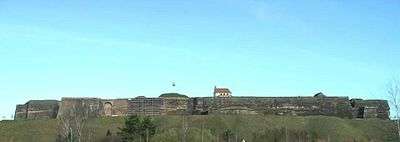
Its administration was modernised, its jurisdiction re-regulated and there was then initially a definite economic boom that had, however, turned into a long-lasting recession in the 2nd quarter of the 17th century.
Communes
.jpg)

| Achen | Ache | Achen |
| Baerenthal | Bäredal | Bärenthal |
| Bettviller | Bettwiller | Bettweiler |
| Bining | Bininge | Biningen |
| Bitche | Bitsch | Bitsch |
| Bousseviller | Busswiller | Busweiler |
| Breidenbach | Breidebach or Breirebach | Breidenbach |
| Éguelshardt | Egelshad or Egelshat | Egelshardt |
| Enchenberg | Enschebärsch | Enchenberg |
| Epping | Eppinge | Eppingen |
| Erching | Erschinge | Erchingen |
| Etting | Ettinge | Ettingen |
| Goetzenbruck | Getzebrikk | Götzenbrück |
| Gros-Réderching | Grossrederschinge | Großrederchingen |
| Hanviller | Honnwiller | Hanweiler |
| Haspelschiedt | Haschbelschitt | Haspelscheidt |
| Hottviller | Hottwiller | Hottweiler |
| Kalhausen | Kalhuse | Kalhausen |
| Lambach | Lambach | Lambach |
| Lemberg | Lembärsch | Lemberg |
| Lengelsheim | Lengelse | Lengelsheim |
| Liederschiedt | Liderschid or Lirerschidt | Liederscheidt |
| Loutzviller | Lutzwiller | Lutzweiler |
| Meisenthal | Meisedal | Meisenthal |
| Montbronn | Mumere | Mombronn |
| Mouterhouse | Muterhüse or Muderhüse | Mutterhausen |
| Nousseviller-lès-Bitche | Nusswiller | Nussweiler |
| Obergailbach | Owergäälbach | Obergailbach |
| Ormersviller | Ormerschwiller | Ormersweiler |
| Petit-Réderching | Kläänrederschinge | Kleinrederchingen |
| Philippsbourg | Phillipsburch or Fillipsbueri | Philippsburg |
| Rahling | Rahlinge | Rahlingen |
| Reyersviller | Reierschwiller | Reyersweiler |
| Rimling | Rimlinge | Rimlingen |
| Rohrbach-lès-Bitche | Roerbach | Rohrbach |
| Rolbing | Rolwinge | Rolbingen |
| Roppeviller | Roppwiller | Roppweiler |
| Saint-Louis-lès-Bitche | Minzdal | Münzthal |
| Schmittviller | Schmittwiller | Schmittweiler |
| Schorbach | Schorbach | Schorbach |
| Schweyen | Schweije | Schweyen |
| Siersthal | Siirschel | Siersthal |
| Soucht | Sucht | Sucht |
| Sturzelbronn | Stirzelbrunn | Stürzelbronn |
| Volmunster | Wolminschter | Wolmünster |
| Waldhouse | Waldhuse or Walthuse | Waldhausen |
| Walschbronn | Walschbronn | Walschbronn |
References
Bibliography
- Beck, Joël (1999). Les moulins et scieries du Pays de Bitche (in French).
- Beck, Joël (2005). Le Pays de Bitche 1900-1939 (in French). p. 128.
- Glath, Paul-Édouard (1997). Du pays de Bitche en Charente-Maritime : Souvenirs de 1939-40 (in French). p. 94.
- Hemmert, Didier (1998). Le Pays de Bitche (in French).
- Kochert, Francis; Michaux, Laurette; Michaux, Gérard (2008). Moselle : Metz et le pays messin, pays de Bitche, Nied, Sarrebourg, Saulnois, trois frontières et bassin houiller (in French). p. 345.
- Lauer, Auguste (1965). La syllabe "bach" dans la toponymie du pays de Bitche (in French).
- Rittgen, Francis (1988). Bitche et son canton, des origines à 1945 (in French).
- Robin, Bernard (1984). Les Grelots du vent, images et mirages du Pays de Bitche (in French).
- Robin, Bernard (1989). Un sablier de brumes (in French).
- Robin, Bernard (1992). Manteaux de grès et dentelles de sapin (in French).
- Schaefer, Joseph (2004). Le Pays de Bitche, passionnément (in French). p. 174.
- Schutz, André (1992). Bitche et son pays (in French).
External links
- "Pays de Bitche tourist information center".
- "Official website for the town of Bitche" (in French).
- "Information on all towns and villages" (in French).
- "Société d'Histoire et d'Archéologie de Lorraine - Section du Pays de Bitche" (in French).
